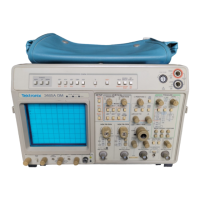Operation
Display Operation
Set both INTENSITY and READOUT INTENSITY controls for comfortable viewing,
but no brighter than you need. Use high intensity settings
to
observe low repetition-
rate signals, narrow pulses
in
long time intervals,
or
occasional variations
in
fast
signals.
Signal Connections
A probe
is
usually the most convenient way
to
connect
an
input signal
to
the
instrument.
Shielded to prevent pickup
of
electromagnetic interference, the standard
10X probes supplied with the instrument present a high impedance to a circuit under
test. While the 1
a
MQ
and
11
pF
of
the probe are a negligible load on most circuits,
very fast circuits
or
very high impedance circuits may be seriously affected.
Waveform Fidelity
and
Probe Grounds
A probe ground must be used for accurate measurements and observations.
Use the shortest ground connection possible if you want good waveform
fidelity.
The standard-accessory probe
is
a compensated 10X voltage divider.
It
appears resistive at low frequencies and capacitive for high-frequency signal
components. The probe input capacitance can interact with the inductance of
either a long signal lead
or
a long ground lead to form a series-resonant circuit.
This circuit can affect system bandwidth and can ring if driven by a fast step.
Always keep both the ground
lead and the probe signal-input connections as
short as possible
to
maintain the best waveform fidelity.
In
some cases, a separate ground from the unit under test to the ground
receptacle on the oscilloscope front
panel can reduce interference from low-
frequency hum and noise. For rough checks
of
larger Signals, such as 5-volt
logiC,
a ground lead separate from the probe
or
even the safety ground
connection which
is
shared with the unit under test may work for a signal
ground. Fast signal transitions will be highly distorted and extraneous noise will
be induced without the probe ground connection.
Probe Compensation
2-12
Misadjustment of probe compensation is a common source of measurement
error.
Due
to
variations in oscilloscope input characteristics, probe
compensation should be checked whenever the probe is moved from one
oscilloscope
to
another
or
between channels
of
a multichannel oscilloscope.
See the procedure in the "Checks and Adjustments' section
of
the manual.
2465A/2455A/2445A Operators

